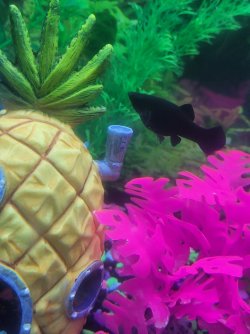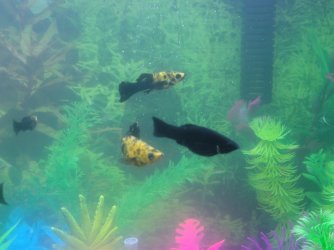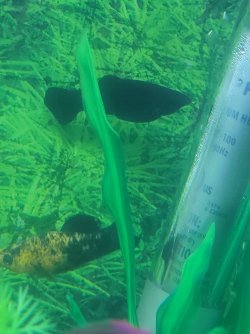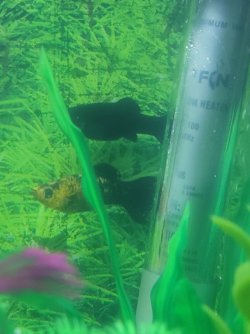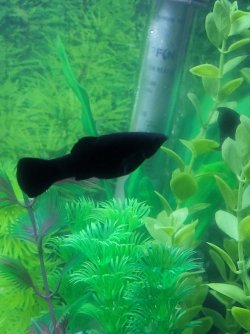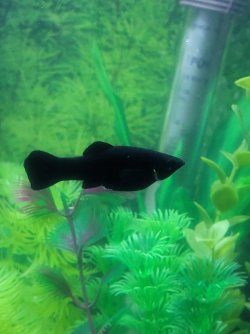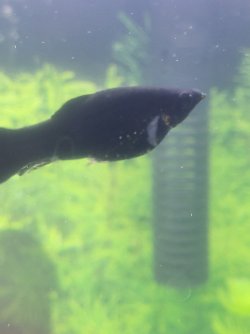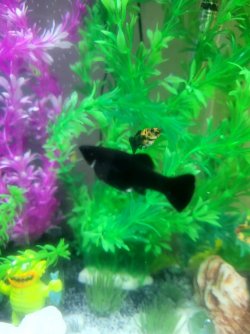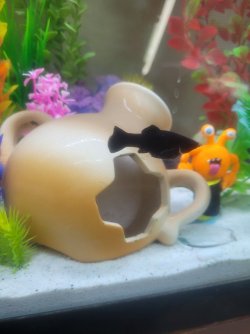I'm currently treating my tank for ice as one of the neon tetras we got seems to have brought it with... but I have this black molly who I've noticed is square and chubbier (?) Than the other fish. Is she fat or am I to be expecting fry soon? I want to be able to be prepared as its something my kids want to be able to experience. Shes been this way almost the whole nearly 2 weeks we've had her.. these are pictures taken 9 days apart the second two being today.
You are using an out of date browser. It may not display this or other websites correctly.
You should upgrade or use an alternative browser.
You should upgrade or use an alternative browser.
Fat or pregnant molly?
- Thread starter Jmw0922
- Start date
The April FOTM Contest Poll is open!

🏆 Click to vote! 🏆
Seems like she's pregnant. And indeed, already squaring off.
Is she more square now? She has seemed kind of Squarish since we got her which was just about 2 weeks ago... heres better pictures from todaySeems like she's pregnant. And indeed, already squaring off.
Attachments
She's gravid for sure, and if @emeraldking says so, you can trust his word, he's a livebearer authority  Plus you have males in the same tank that are courting her in the photo by the looks of it, so it's only a matter of time. How many male mollies do you have and how many females?
Plus you have males in the same tank that are courting her in the photo by the looks of it, so it's only a matter of time. How many male mollies do you have and how many females?
When you say you want to be prepared for when she has her fry, what do you mean to do? Because some methods, like moving the female to a breeder box when she goes into labour can cause a lot of stress and even injury to the female by being netted while so heavily gravid, and stress is never good in any species during labour.
But there are other things you can do that help give the fry the best chance of survival. Some use a separate breeding tank, moving the female to that tank to birth then removing her after -if you wanted to do this, it's important for the other tank to be cycled and prepared, and to use a container like a jug to catch and move the female inside the jug of water, rather than lifting her out with a net.
Or you can use a breeder box/net/tank, but only capture the fry after birth and move them to safety then. Again, there are tips and methods to give you the best chances of saving them all, like checking the tank first thing in the morning for fry hiding at the surface plants or on the substrate, and using a torch to see, catching them before the other fish are awake and alert and likely to eat them.
Adding lots of dense floating plant matter is probably the easiest, safest way to give the fry the best chance of survival in a community tank. a load of elodea, water sprite, guppy grass, hornwort - cheap, easy to grow stem plants that can form a dense little thicket. The fry will naturally head to a load of plant on the surface like that, and can navigate around it to hide from hungry adults much more easily than the adult sized fish can. You can feed the adult fish on the other side of the tank and the crush some food very fine for the fry, and give it them directly in the plant "nursery" so they don't have to risk venturing out among the adults for food. Once the fry are a few weeks old, they'll start to swim out in the open on their own, as they know they're now large enough that the adults can't eat them.
If you let us know what you'd like to try to do, we can share more tips As an adult it's a lot of fun to raise livebearer fry (for a while at least, the numbers do tend to get overwhelming after a while!) but it's also a great learning process for kids.
As an adult it's a lot of fun to raise livebearer fry (for a while at least, the numbers do tend to get overwhelming after a while!) but it's also a great learning process for kids. 
When you say you want to be prepared for when she has her fry, what do you mean to do? Because some methods, like moving the female to a breeder box when she goes into labour can cause a lot of stress and even injury to the female by being netted while so heavily gravid, and stress is never good in any species during labour.
But there are other things you can do that help give the fry the best chance of survival. Some use a separate breeding tank, moving the female to that tank to birth then removing her after -if you wanted to do this, it's important for the other tank to be cycled and prepared, and to use a container like a jug to catch and move the female inside the jug of water, rather than lifting her out with a net.
Or you can use a breeder box/net/tank, but only capture the fry after birth and move them to safety then. Again, there are tips and methods to give you the best chances of saving them all, like checking the tank first thing in the morning for fry hiding at the surface plants or on the substrate, and using a torch to see, catching them before the other fish are awake and alert and likely to eat them.
Adding lots of dense floating plant matter is probably the easiest, safest way to give the fry the best chance of survival in a community tank. a load of elodea, water sprite, guppy grass, hornwort - cheap, easy to grow stem plants that can form a dense little thicket. The fry will naturally head to a load of plant on the surface like that, and can navigate around it to hide from hungry adults much more easily than the adult sized fish can. You can feed the adult fish on the other side of the tank and the crush some food very fine for the fry, and give it them directly in the plant "nursery" so they don't have to risk venturing out among the adults for food. Once the fry are a few weeks old, they'll start to swim out in the open on their own, as they know they're now large enough that the adults can't eat them.
If you let us know what you'd like to try to do, we can share more tips
I don't plan to move her. I tried that when I first suspected and noticed it was stressing her to catch her so I gave up and then read about how moving them can stress them. I plan to hopefully catch the fry and put them in a separate nursery tank. We just upgraded our tank due to possible fry and wanting to save as many as we can. As far as live plants I currently don't have any besides lucky bamboo in our filter to help things in that aspect. I want to get some but I also need live plants that won't be excessive or a lot of maintenance. Any suggestions?She's gravid for sure, and if @emeraldking says so, you can trust his word, he's a livebearer authorityPlus you have males in the same tank that are courting her in the photo by the looks of it, so it's only a matter of time. How many male mollies do you have and how many females?
When you say you want to be prepared for when she has her fry, what do you mean to do? Because some methods, like moving the female to a breeder box when she goes into labour can cause a lot of stress and even injury to the female by being netted while so heavily gravid, and stress is never good in any species during labour.
But there are other things you can do that help give the fry the best chance of survival. Some use a separate breeding tank, moving the female to that tank to birth then removing her after -if you wanted to do this, it's important for the other tank to be cycled and prepared, and to use a container like a jug to catch and move the female inside the jug of water, rather than lifting her out with a net.
Or you can use a breeder box/net/tank, but only capture the fry after birth and move them to safety then. Again, there are tips and methods to give you the best chances of saving them all, like checking the tank first thing in the morning for fry hiding at the surface plants or on the substrate, and using a torch to see, catching them before the other fish are awake and alert and likely to eat them.
Adding lots of dense floating plant matter is probably the easiest, safest way to give the fry the best chance of survival in a community tank. a load of elodea, water sprite, guppy grass, hornwort - cheap, easy to grow stem plants that can form a dense little thicket. The fry will naturally head to a load of plant on the surface like that, and can navigate around it to hide from hungry adults much more easily than the adult sized fish can. You can feed the adult fish on the other side of the tank and the crush some food very fine for the fry, and give it them directly in the plant "nursery" so they don't have to risk venturing out among the adults for food. Once the fry are a few weeks old, they'll start to swim out in the open on their own, as they know they're now large enough that the adults can't eat them.
If you let us know what you'd like to try to do, we can share more tipsAs an adult it's a lot of fun to raise livebearer fry (for a while at least, the numbers do tend to get overwhelming after a while!) but it's also a great learning process for kids.

Also because they currently do have ick, what is the best treatment for them? I've got a few products but the product I used first doesn't seem to be doing anything for that. Especially with a gravid fish and possible fry. I know I will need to move the snails.
We have grown a huge attachment to our mollies and I don't want anything to happen to them...
Also we have 2 male mollies and 7 female mollies.She's gravid for sure, and if @emeraldking says so, you can trust his word, he's a livebearer authorityPlus you have males in the same tank that are courting her in the photo by the looks of it, so it's only a matter of time. How many male mollies do you have and how many females?
When you say you want to be prepared for when she has her fry, what do you mean to do? Because some methods, like moving the female to a breeder box when she goes into labour can cause a lot of stress and even injury to the female by being netted while so heavily gravid, and stress is never good in any species during labour.
But there are other things you can do that help give the fry the best chance of survival. Some use a separate breeding tank, moving the female to that tank to birth then removing her after -if you wanted to do this, it's important for the other tank to be cycled and prepared, and to use a container like a jug to catch and move the female inside the jug of water, rather than lifting her out with a net.
Or you can use a breeder box/net/tank, but only capture the fry after birth and move them to safety then. Again, there are tips and methods to give you the best chances of saving them all, like checking the tank first thing in the morning for fry hiding at the surface plants or on the substrate, and using a torch to see, catching them before the other fish are awake and alert and likely to eat them.
Adding lots of dense floating plant matter is probably the easiest, safest way to give the fry the best chance of survival in a community tank. a load of elodea, water sprite, guppy grass, hornwort - cheap, easy to grow stem plants that can form a dense little thicket. The fry will naturally head to a load of plant on the surface like that, and can navigate around it to hide from hungry adults much more easily than the adult sized fish can. You can feed the adult fish on the other side of the tank and the crush some food very fine for the fry, and give it them directly in the plant "nursery" so they don't have to risk venturing out among the adults for food. Once the fry are a few weeks old, they'll start to swim out in the open on their own, as they know they're now large enough that the adults can't eat them.
If you let us know what you'd like to try to do, we can share more tipsAs an adult it's a lot of fun to raise livebearer fry (for a while at least, the numbers do tend to get overwhelming after a while!) but it's also a great learning process for kids.

Oh dear lord above - you're gonna have more fry than you know what to do with soon!Also we have 2 male mollies and 7 female mollies.

I have a real soft spot for mollies, especially black mollies - the first fish I bred;
I miss having them (the large adults lived for around eight years, and got really large by the end, they never seemed to stop growing) and I'm always sorely tempted to get them again. I will one day.
Plants - any of the live plants I listed above are easy for beginners, don't require much maintenance, can literally throw them into the tank and leave them to float and do their thing, and they will grow. They improve water quality by taking up and using the ammonia the fish produce, fish really enjoy having the live plants, and the only real maintenance they need is to remove some during your normal tank maintenance if they've grown more than you want.
Easy, slow growing plants for the bottom are crytocorynes, java ferns, and any of the mosses. Java ferns and mosses need to be attached to hardscape or weighted down rather than planted in the gravel, but apart from that don't need much other help. But for livebearer fry, something floating at the surface is my best suggestion, like the first plants listed.
Ich treatment - I think making another thread specifically about treating the ich is best, so the right people see it. Please don't throw random meds in there, that can be dangerous, especially if they interact with each other. How sure are you that it's even ich? Clear photos of the affected fish will help, even video. If you do take video though, be aware the vid upload feature on the site doesn't work, but if you upload to youtube, you can link it here. In the new thread give as much info about the tank as possible - since we can't see or test it ourselves, the info you give is all we'll have to go on, so detail is appreciated! If you copy paste the template below and fill it out, making the thread in the emergencies section asking for help with ich, you're likely to get help from people who know a lot more than I do.
Template:
Tank size:
tank age:
pH:
ammonia:
nitrite:
nitrate:
kH:
gH:
tank temp:
Fish Symptoms (include full description including lesion, color, location, fish behavior):
Volume and Frequency of water changes:
Chemical Additives or Media in your tank:
Tank inhabitants:
Recent additions to your tank (living or decoration):
Exposure to chemicals:
Digital photo (include if possible):
I wouldn't call her more squared off per se in comparison to the first photos. But yes, she does look gravid.Is she more square now? She has seemed kind of Squarish since we got her which was just about 2 weeks ago... heres better pictures from today
Looking at her today... she's got this little like grayish looking lump right above her anal vent... ? Of course I caught this mid poop but it's the best I could get.I wouldn't call her more squared off per se in comparison to the first photos. But yes, she does look gravid.
Looking at her today... she's got this little like grayish looking lump right above her anal vent... ? Of course I caught this mid poop but it's the best I could get.
Attachments
A bit hard to tell when she's due... The problem with pregnant female mollies is that they can drop fry while they ain't that big yet but they can also become very huge before they'll drop fry. So, it's a bit hard to estimate the due day. But squaring off is always a sign that she can be close. But a pregnant female doesn't have to square off to drop fry. For squaring off means only that a female is using her maximum gestation period before dropping fry.
Just give it some time... But she's not extremely fat. It's more a beautiful build female. A healthy non pregnant female may have a nice shaped belly.Still no fry... this is her today. Starting to think she's just fat.
NearMeBettas
Fishaholic
She looks to be gravid. Patience lol, sometimes it can feel like forever and I'm like, come on little fish! I highly doubt you will catch her birthing. They do it fast, and sometimes in the middle of the night. I've only caught a couple of my girls.
Latest Discussions
- Replies
- 0
- Views
- 32
- Replies
- 0
- Views
- 18
- Replies
- 0
- Views
- 21
- Replies
- 2
- Views
- 50
trending
-
-
-
-
-
F-1 Angel... a bit nervous... it'll be my 1st F-1 fish...
- Started by Magnum Man
- Replies: 17
Staff online
-
FishmanicTFF Contest Czar

